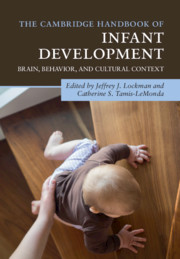Book contents
- The Cambridge Handbook of Infant Development
- The Cambridge Handbook of Infant Development
- Copyright page
- Dedication
- Contents
- Illustrations
- Contributors
- Preface
- Part I Foundations
- Part II Perceptual Development
- Part III Cognitive Development
- Part IV Action
- 17 Action in Development
- 18 The Mirror Neuron System and Social Cognition
- 19 Infant Object Manipulation and Play
- 20 The Infant’s Visual World
- Part V Language
- Part VI Emotional and Social Development
- Index
- References
18 - The Mirror Neuron System and Social Cognition
from Part IV - Action
Published online by Cambridge University Press: 26 September 2020
- The Cambridge Handbook of Infant Development
- The Cambridge Handbook of Infant Development
- Copyright page
- Dedication
- Contents
- Illustrations
- Contributors
- Preface
- Part I Foundations
- Part II Perceptual Development
- Part III Cognitive Development
- Part IV Action
- 17 Action in Development
- 18 The Mirror Neuron System and Social Cognition
- 19 Infant Object Manipulation and Play
- 20 The Infant’s Visual World
- Part V Language
- Part VI Emotional and Social Development
- Index
- References
Summary
The ability to understand others’ actions and intentions is at the core of human social competence. Action understanding, what it means and how it develops, has received much attention in developmental research because it is viewed as one of the most fundamental abilities in early social-cognitive development. For example, there is a growing body of evidence linking early action understanding with later theory of mind (Brooks & Meltzoff, 2015; Charman et al., 2000; Wellman, Phillips, Dunphy-Lelii, & LaLonde, 2004), and to the development of communicative skills (e.g., Brooks & Meltzoff, 2008). Increasing evidence suggests that the mirror neuron system (MNS) is a key neural correlate of action understanding. In this chapter, we discuss the role the MNS is thought to play in the development of social cognitive skills in infancy. We also discuss the current challenges of measuring the MNS that are unique to work with infants, what such studies have found in both typical and atypical populations, and how this work can impact our understanding of development.
- Type
- Chapter
- Information
- The Cambridge Handbook of Infant DevelopmentBrain, Behavior, and Cultural Context, pp. 495 - 519Publisher: Cambridge University PressPrint publication year: 2020
References
- 1
- Cited by



